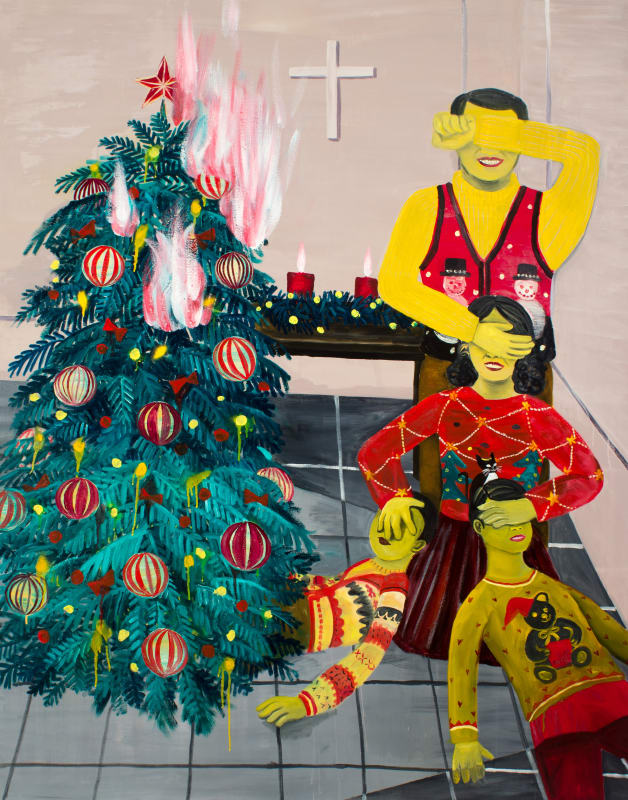To mark Mori Art Museum's 15th year, "Catastrophe and the Power of Art" brings together artworks depicting human and natural disasters in a serious and thought-provoking exhibition. Addressing events as significant as 9.11, the global financial crisis or the Great East Japan Earthquake, it portrays many of the catastrophes of the early 21st century. Despite its somber tone, there are occasional moments of respite. In the third room is one such occasion, where the Taiwanese artist Hai-Hsin Huang's canvases of awkward tableaux can be found. Here, the artist's darkly comic paintings describe more personal, socially-informed ideas of what catastrophe means.
Metropolis: I understand that you are now based in New York and that this is your first museum show in Japan. Do you often visit or work in Japan?
Hai-Hsin Huang: That's right. I visited Tokyo many times with my parents when I was a kid, but this year was the first time that I worked in Tokyo as an artist when I took part in the artist-in-residence programme at 3331 Arts Chiyoda.
M: How did you feel when you were asked to participate in a show with the word "catastrophe" in the title?
HH: I was very excited about participating in "Catastrophe and the Power of Art." I had been playing with ideas about fear in personal and daily life, and in public society, so this is absolutely a title that I am interested in.
M: Tell us a little about the paintings that the curator choose to display.
HH: I have five pieces in the show: "Thanksgiving," "Silent Night," "Swan Lake #2," "Red Carpet Dream #3," and "Birthday Crisis Study." These paintings are obviously disastrous but lighthearted and humorous at the same time. These are all very recognisable, either from holiday celebrations or social events like weddings. Ordinarily, of course, these events are supposed to be happy occasions. I tried to create different situations to cast doubt over these very common and cliched ideas. People don't usually question these conventions.
M: Every artist has their own method. How do you make art?
HH: I get inspired by the scenes I witness in daily life. I then attach a psychological add-on. It's not like I get inspired all the time, but once I have an image in mind, I start to paint very quickly to capture it.
M: How do you imagine the viewer feels when seeing your paintings?
HH: I assume people would laugh a bit. Not a belly laugh, more like the kind of bitter, awkward chuckle.
M: One of the things that people assume when viewing art is that the artist's own life informs the artwork. Have you ever experienced anything like the things you have painted?
HH: I paint the scenes that I have witnessed in daily life but with exaggeration and imagination. I like to paint things that people are familiar with, things that they can relate to or resonate with.
M: A lot of your work involves people in public situations or at social events; at birthday parties, weddings or on red carpets. What attracts you to these situations?
HH: I made these paintings not long after I graduated from art school. I was trying to adjust to life while I was still new to living in a foreign county. Many of my close friends got married and had kids, but I still felt I was a kid trying to explore the world and myself, all the while celebrating American holidays with people and trying hard to have fun like everyone else.
M: How did these experiences affect your thinking?
HH: I had many doubts about the social conventions of marriage and wedding ceremonies, the things that are supposed to be so important that you are not allowed to fail at. On the other hand, they could also be ridiculous and out of date, but people are so slow and afraid to change. The world is getting sicker today. We need to change old behaviors and values, but instead of taking action I feel that most of us just sit there and watch the tragedies happen as we expect them to.
M: There is a dark humor that runs through your work. Is tragedy ever funny?
HH: Of course, tragedy is not funny, but funniness isn't really the point either. It's more about the reaction to certain social expectations. People tend (at least I do) to laugh hollowly through an awkward situation. It's as though everyone knows things aren't going right and everyone is secretly anticipating the worst outcome, but no one would say anything until a child suddenly says something to point it out.
M: Do you think that art can overcome catastrophe?
HH: I can't say that art can overcome catastrophe, but I feel that dark humor is filling our daily lives. Art can lead us to see and think about things differently. And that's a start.
"Catastrophe and the Power of Art" runs until January 20, 2019.
52F/53F, Roppongi Hills Mori Tower, 6-10-1 Roppongi, Minato-ku
https://www.mori.art.museum/en/



